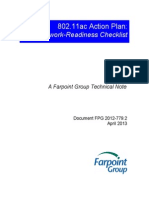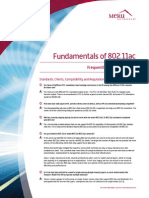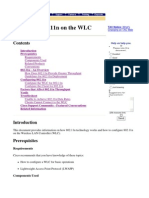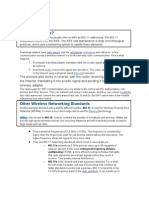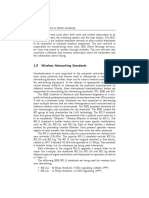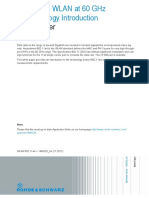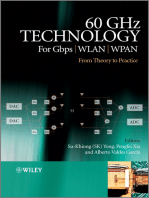Frequently Asked Questions
Frequently Asked Questions
Uploaded by
gesperCopyright:
Available Formats
Frequently Asked Questions
Frequently Asked Questions
Uploaded by
gesperOriginal Title
Copyright
Available Formats
Share this document
Did you find this document useful?
Is this content inappropriate?
Copyright:
Available Formats
Frequently Asked Questions
Frequently Asked Questions
Uploaded by
gesperCopyright:
Available Formats
802.
11ac FREQUENTLY ASKED QUESTIONS December 2011
80211.ac Frequently Asked Questions AP-120 SERIES CONFIGURATION GUIDE
Table of Contents
General Questions: .................................................................................................................... 3 1. 2. 3. 5. 6. 7. 8. 9. What is 802.11ac? ............................................................................................................. 3 When will 802.11ac be ratified into a standard? ................................................................. 3 When will enterprise 802.11ac access points be available? .............................................. 3 Will 802.11ac come out before 4-stream 802.11n products? ............................................. 3 Is Aruba part of the standards committee for 802.11ac?.................................................... 3 How does 802.11ad compare to AC? Is this the same? ................................................... 3 What about the reclaimed TV whitespace spectrum? ........................................................ 3 When will clients support 802.11ac? .................................................................................. 4
10. When will Aruba have 802.11ac APs? ............................................................................... 4 11. How fast will 802.11ac be? ................................................................................................ 4 12. Will 802.11ac be backwards compatible? .......................................................................... 4 Technical Questions: .................................................................................................................. 4 14. How does 802.11ac gain its speed? .................................................................................. 4 15. How does the Downlink multi-user MIMO work? ................................................................ 5 16. Will I be able to upgrade the radios in my 11n APs to support 802.11ac? ......................... 5 17. Is it true that 802.11ac will only work in the 5 GHz band? .................................................. 5 18. How many 80 MHz and 160 MHz channels are there in the 5 GHz band? ........................ 6 19. Will I need to buy new switches to support 802.11ac? ....................................................... 6 20. How fast will 802.11ac be? ................................................................................................ 6
Page 2
80211.ac Frequently Asked Questions AP-120 SERIES CONFIGURATION GUIDE
General Questions:
1. What is 802.11ac? 802.11ac is the next evolution of WiFi. First there was 802.11b which provided up to 11 mbps data rates per radio in the 2.4 GHz spectrum. The next evolution was 802.11a which provided up to 54 mbps data rates per radio in the 5 GHz spectrum. 802.11g came out shortly after enabling 54 mbps per radio in the 2.4 GHz spectrum. 802.11n was ratified in 2009. The 802.11n spec allows for data rates up to 600 mbps per radio and the current generation of 802.11n allows for up to 450 mbps per radio. 802.11ac builds on 11n and enable wireless speeds over a gigabit per second. 2. When will 802.11ac be ratified into a standard? The 802.11ac project was approved in September 2008. Draft 1.3 is currently available. The internal working groups November 2011 ballot did not pass. It required 75% approval and it failed with 74% approval. Efforts are underway to address the comments and get a draft 2.0 standard. Final ratification is expected in 2013. 3. When will enterprise 802.11ac access points be available? Enterprise 802.11ac access points are expected to hit the market sometime in 2013. Consumer devices may hit earlier. The first generation of 11ac products will likely be based on a draft of the spec similar to 802.11n.
4. Will there be phases to 802.11ac support like there were to 11n?
Yes. Early 802.11ac products are expected to support up to 4 spatial streams, 80 MHz channel widths and the 256-QAM. Later 802.11ac products will enable the full potential of the standard by supporting downlink multi-user MIMO and 160 MHz channels. 5. Will 802.11ac come out before 4-stream 802.11n products? It looks like most manufacturers will leapfrog the 4-stream 802.11n products in favor of 802.11ac products. 6. Is Aruba part of the standards committee for 802.11ac? Aruba Networks is active in both IEEE, including the IEEE 802.11ac Task Group, and the Wi-Fi Alliance, including task groups developing the interoperability certification program for IEEE 802.11ac. 7. How does 802.11ad compare to AC? Is this the same? 802.11ad uses the 60 GHz spaces to push wireless traffic up to 7 gpbs over short distances. Signals will not travel nearly as far in the 60 GHz space as they do in the 2.4 and 5 GHz spaces used by 802.11a/b/g/n/ac. 802.11ad will likely be a replacement for shorter cables like HDMI, USB, etc. It will enable wireless laptop docks, wirelessly pushing video to HDTVs, etc. 8. What about the reclaimed TV whitespace spectrum?
Page 3
80211.ac Frequently Asked Questions AP-120 SERIES CONFIGURATION GUIDE
The reclaimed spectrum presents some interesting possibilities but it also has some limitations. The reclaimed spectrum propagates significantly farther than the existing WiFi channels. This will result in significant increases in interference. Products are still being investigated. 802.11ac will be productized well before whitespace products. 9. When will clients support 802.11ac? 802.11ac clients are likely to start appearing in 2013, roughly around the same time as the APs. 802.11ac is backwards compatible and will support 802.11a/b/g/n clients. 10. When will Aruba have 802.11ac APs? Aruba Networks is not able to talk about unannounced products and release dates. Aruba Networks focuses on cutting edge technology and support for new standards. The AP-12X family of APs was one of the first enterprise 11n APs on the market when it was released in Feb of 2008. It was based on draft 2.0 of the standard and was released well before the standard was formally ratified in Oct of 2009. 11. How fast will 802.11ac be? Similar to 802.11n, 802.11ac speeds will vary depending on the hardware configuration of the device. 802.11ac will enable speeds beyond 500 Mbps for a single client and 1 Gbps per radio. 12. Will 802.11ac be backwards compatible? Yes. 11a/b/g/n devices will be able to connect to 802.11ac radios.
13. Should we wait for 802.11ac before making our network upgrade?
No. It is good to be aware of 802.11ac for long term buying and budget planning. 802.11ac is not expected to be available before 2013. Clients will start to appear in 2013 but just like 11n, it will take a while for 11ac client population and other ecosystem devices to gain popularity. 11n investments today will be secure and powerful for years to come.
Technical Questions:
14. How does 802.11ac gain its speed? The 802.11ac protocol has a number of enhancements that will be implemented in multiple phases.
Wider Channel Widths o 80 MHz channels (contiguous) o 160 MHz channels (contiguous or two non-contiguous 80 MHz slices) 256-QAM (Quadrature amplitude modulation) o Provides a 33% increase in throughput over the 64-QAM used in 11n Downlink Multi-user MIMO o Allows 1 AP to transmit unique data to multiple stations simultaneously
Page 4
80211.ac Frequently Asked Questions AP-120 SERIES CONFIGURATION GUIDE
Up to 8 spatial streams o Compared to a maximum of 4 spatial streams in 11n o Up to 8 spatial streams in both single-user and multi-user modes o No more than 4 spatial streams per station in multi-user mode Other Enhancements o Single sounding & feedback format for beam forming (as opposed to multiple, incompatible formats in 11n) o Coexistence mechanisms o Independent virtual carrier sense in sub-channels
15. How does the Downlink multi-user MIMO work? 802.11ac allows the AP to transmit separate streams to each client simultaneously. It is similar to MIMO except the transmissions are to antennas on different receiver devices. The number of spatial streams is limited to the number of transmit chains on the AP. Downlink multi-user MIMO requires some MAC layer enhancements and beam forming. This feature will only work when the AP is transmitting to the client. Client devices will not be able to leverage this feature when they are transmitting to the AP. Downlink multi-user MIMO should allow significantly improved throughput when multiple single and dual stream clients are connected to the AP. Most smartphones and tablets are single stream devices. With 11n only 1 single stream device can download at a time.
16. Will I be able to upgrade the radios in my 11n APs to support 802.11ac? No. 802.11ac will require hardware changes to the radio as well as enhanced CPU processing power. Existing APs will not be able to be upgraded to 802.11ac. 17. Is it true that 802.11ac will only work in the 5 GHz band? Maybe. The spec, as written, only applies to the 5 GHz band. The wide channels provide the majority of speed improvements to 802.11ac and there isnt enough room in the 2.4 GHz band to accommodate the larger channels. Some aspects of 802.11ac including additional spatial streams and 256-QAM are likely to make it into the 2.4 GHz radios at some point.
Page 5
80211.ac Frequently Asked Questions AP-120 SERIES CONFIGURATION GUIDE
18. How many 80 MHz and 160 MHz channels are there in the 5 GHz band? The answer will depend on the regulatory domain of the AP. In the US, there are 5 contiguous 80 MHz channels. Those 80 MHz channels can be combined to create 160 MHz channels. There are only 2 80 MHz channels that do not require DFS. 19. Will I need to buy new switches to support 802.11ac? 802.11ac APs will perform very well when plugged into gigabit ports that support POE+ (802.11at). While the standard supports data rates up to almost 7 gigabits per second (gbps), those rates will not be supported in early products. Early 802.11ac APs are likely to only support up to 3 streams and 80 MHz channels. That puts theoretical radio throughput around 1.3 gbps. Actually throughput will be lower and adequately served by a gigabit port. 802.11ac APs are likely to require POE+ (AT) power due to increased power draws of the faster CPUs and radios. Additionally, even if the AP infrastructure is upgraded, it will take time for the client population to migrate to 802.11ac and for the traffic density to increase. While the APs have to be upgraded to support the first 11ac connection, the controllers and switch upgrades can coincide with the client distribution switch to 802.11ac. 20. How fast will 802.11ac be? This is a surprisingly complicated question. Similar to 802.11n, 802.11ac will vary in speeds depending on the number of spatial streams, guard interval and channel bandwidth available on the AP and the client. The table below outlines some of the data rates in mbps. Like 802.11n, it is likely that many smartphone and tablet clients will be single stream when 11ac is released. Channel bandwidths of 160 MHz will present some RF challenges to enterprise environments and may not be used. MCS Lowest rates Mbps per radio (20MHz channel, 1x SS) Long GI 0 1 2 6.5 13.0 19.5 Short GI 7.2 14.4 21.7 x2.1 for 40MHz x4.5 for 80MHz x2 for 2 SS x3 for 3 SS Channel width Spatial streams Highest rates Mbps per radio (160MHz channel, 8x SS) Long GI 468.0 939.0 1404.0 Short GI 520.0 1040.0 1560.0
Page 6
80211.ac Frequently Asked Questions AP-120 SERIES CONFIGURATION GUIDE
3 4 5 6 7 8 9
26.0 39.0 52.0 58.5 65.0 78.0 (86.7)
28.9 43.3 57.8 65.0 72.2 86.7 (96.3)
x9.0 for 160MHz
x4 for 4 SS x5 for 5 SS x6 for 6 SS x7 for 7 SS x8 for 8 SS
1872.0 2808.0 3744.0 4212.0 4680.0 5616.0 6240.0
2080.0 3120.0 4160.0 4680.0 5200.0 6240.0 6933.3
About Aruba Networks Aruba is the global leader in distributed enterprise networks. Its award-winning portfolio of campus, branch/teleworker, and mobile solutions simplify operations and secure access to all corporate applications and services - regardless of the user's device, location, or network. This dramatically improves productivity and lowers capital and operational costs. Listed on the NASDAQ and Russell 2000 Index, Aruba is based in Sunnyvale, California, and has operations throughout the Americas, Europe, Middle East, and Asia Pacific regions. To learn more, visit Aruba at http://www.arubanetworks.com. For real-time news updates follow Aruba on Twitter, Facebook, or the Green Island News Blog.
Page 7
80211.ac Frequently Asked Questions AP-120 SERIES CONFIGURATION GUIDE
1344 Crossman Ave. Sunnyvale, CA 94089-1113 Tel.. 1.408.227.4500 | Fax. +1.408.227.4550 | info@arubanetworks.com | arubanetworks.com
2011 Aruba Networks, Inc. AirWave, Aruba Networks, Aruba Mobility Management System, Bluescanner, For Wireless That Works, Mobile Edge Architecture, People Move. Networks Must Follow, RFprotect, The All Wireless Workplace Is Now Open For Business, Green Island, and The Mobile Edge Company are trademarks of Aruba Networks, Inc. All rights reserved. Aruba Networks reserves the right to change, modify, transfer, or otherwise revise this publication and the product specifications without notice. While Aruba uses commercially reasonable efforts to ensure the accuracy of the specifications contained in this document, Aruba will assume no responsibility for any errors or omissions. Note: All scaling metrics outlined in this document are maximum supported values. The scale may vary depending upon the deployment scenario and features enabled.
Page 8
You might also like
- The 802.11 Family ExplainedDocument2 pagesThe 802.11 Family ExplainedWella Binay BuenaobraNo ratings yet
- Ieee 802.11Document13 pagesIeee 802.11Cesar Santiago Bolaño SalazarNo ratings yet
- Indoor Radio Planning: A Practical Guide for 2G, 3G and 4GFrom EverandIndoor Radio Planning: A Practical Guide for 2G, 3G and 4GRating: 5 out of 5 stars5/5 (1)
- 802.11ac: The Fifth Generation of Wi-Fi: Technical White PaperDocument25 pages802.11ac: The Fifth Generation of Wi-Fi: Technical White PaperSubash ShresthaNo ratings yet
- Next Generation 802.11ac SOLUTION: Fact SheetDocument2 pagesNext Generation 802.11ac SOLUTION: Fact Sheetducquang89No ratings yet
- 802.11ac Action Plan:: A Network-Readiness ChecklistDocument9 pages802.11ac Action Plan:: A Network-Readiness Checklista_sahaiNo ratings yet
- What Is 802.11acDocument5 pagesWhat Is 802.11acahmed sheikhNo ratings yet
- Motoroal - 802.11ac White PaperDocument10 pagesMotoroal - 802.11ac White PaperL1architectNo ratings yet
- 802 11acDocument29 pages802 11acHarshaNo ratings yet
- 802.11 StandardDocument3 pages802.11 StandardDaljit SinghNo ratings yet
- Gigabit Wireless Lans: An Overview of Ieee 802.11ac and 802.11adDocument12 pagesGigabit Wireless Lans: An Overview of Ieee 802.11ac and 802.11adIulik BrumaNo ratings yet
- What Is 802.11ac Wi-Fi, and How Much Faster Than 802Document17 pagesWhat Is 802.11ac Wi-Fi, and How Much Faster Than 802uoejduyelasdeNo ratings yet
- 802.11ac: The Fifth Generation of Wi-Fi: Technical White PaperDocument20 pages802.11ac: The Fifth Generation of Wi-Fi: Technical White PaperchopanalvarezNo ratings yet
- WiFi Standards 802.11a B G N vs. 802.11acDocument3 pagesWiFi Standards 802.11a B G N vs. 802.11acDavid SofitaNo ratings yet
- How To Cable 802.11n Wireless Access Points: White PaperDocument5 pagesHow To Cable 802.11n Wireless Access Points: White Paperabul abbasNo ratings yet
- 802.11ac The Fifth PDFDocument20 pages802.11ac The Fifth PDFjamal abkiNo ratings yet
- 802.11 - Wi-Fi Standards and Speeds Explained - Network World PDFDocument6 pages802.11 - Wi-Fi Standards and Speeds Explained - Network World PDFTecnologia MasterNo ratings yet
- 7signal Wireless 802.11ac Migration Real World Best PracticesDocument17 pages7signal Wireless 802.11ac Migration Real World Best Practicesxaroxe5366No ratings yet
- 802.11ac Overview: Why Is 802.11ac Needed?Document4 pages802.11ac Overview: Why Is 802.11ac Needed?javierdb2012No ratings yet
- Inside 802.11n Wireless LANsDocument16 pagesInside 802.11n Wireless LANsJosué JuniorNo ratings yet
- White Paper: 802.11ac Survey: Gigabit Wifi Has ArrivedDocument9 pagesWhite Paper: 802.11ac Survey: Gigabit Wifi Has ArrivedAndyNo ratings yet
- Understanding Technology Options For Deploying Wi-Fi White PaperDocument43 pagesUnderstanding Technology Options For Deploying Wi-Fi White Paperophyx007No ratings yet
- Introduction To WLAN TestingDocument42 pagesIntroduction To WLAN TestingGabriel SilvaNo ratings yet
- 2012 Faq 802.11ac Standards Clients Compatibility RegulationsDocument0 pages2012 Faq 802.11ac Standards Clients Compatibility Regulationsjavierdb2012No ratings yet
- Wi Fi 6 - White PaperDocument21 pagesWi Fi 6 - White PaperĐinh Nhất LinhNo ratings yet
- 802.11 Overview PDFDocument8 pages802.11 Overview PDFSandeep PandeyNo ratings yet
- A Survey On Wireless Networks-Final Report PDFDocument44 pagesA Survey On Wireless Networks-Final Report PDFosmanatamNo ratings yet
- Huawei Wi-Fi 6 METODOLOGIA (IEEE 802.11ax) Technology White PaperDocument29 pagesHuawei Wi-Fi 6 METODOLOGIA (IEEE 802.11ax) Technology White PaperLeidy ChNo ratings yet
- History of 802Document2 pagesHistory of 802Xebi ShiekhNo ratings yet
- WP-802.11nPrimer OKDocument15 pagesWP-802.11nPrimer OKNoha AminNo ratings yet
- Deepika WifiDocument9 pagesDeepika WifiAnubhuti JalanNo ratings yet
- Wi-Fi Best PracticesDocument7 pagesWi-Fi Best Practiceshotsync101No ratings yet
- 802.11n Config On WLCDocument16 pages802.11n Config On WLCWaqas AkhtarNo ratings yet
- New Microsoft Word DocumentDocument2 pagesNew Microsoft Word Documentcharles mainaNo ratings yet
- 802.11n Wireless Technology Overview: Deploying The Next Generation of High Performance WirelessDocument7 pages802.11n Wireless Technology Overview: Deploying The Next Generation of High Performance WirelessswalayNo ratings yet
- Understanding 802,11 AdDocument68 pagesUnderstanding 802,11 AdArash Mazandarani100% (2)
- Term Paper Synopsis - 1Document6 pagesTerm Paper Synopsis - 1psdNo ratings yet
- 5G Vs WiFi 6Document14 pages5G Vs WiFi 6Bala JE/BSNLNo ratings yet
- White Paper - IEEE 802Document16 pagesWhite Paper - IEEE 802Prashant PavaskarNo ratings yet
- ST Paul'S University Nairobi CampusDocument8 pagesST Paul'S University Nairobi CampusQui BuiNo ratings yet
- H12-311 HCIA - WLAN: FalseDocument14 pagesH12-311 HCIA - WLAN: FalseАгрепина ДворецкаяNo ratings yet
- 802.11 WlanDocument27 pages802.11 WlanAparnaSkpNo ratings yet
- UntitleddocumentDocument5 pagesUntitleddocumentArpit TiwariNo ratings yet
- CS8601-Mobile Computing (Wireless Networking Standards Notes) ياسرDocument4 pagesCS8601-Mobile Computing (Wireless Networking Standards Notes) ياسرYasar BilalNo ratings yet
- AbgnhDocument12 pagesAbgnhعقود السمNo ratings yet
- Understanding and Optimizing 802.11Document8 pagesUnderstanding and Optimizing 802.11brancilosNo ratings yet
- Cabling Infrastructure For Next Generation Wireless Access Points, 802.11ac and BeyondDocument2 pagesCabling Infrastructure For Next Generation Wireless Access Points, 802.11ac and BeyondCarlos Buznego NiochetNo ratings yet
- Offensive Security WirelessDocument193 pagesOffensive Security Wireless0day adminNo ratings yet
- IEEE 802.16 Standards and Amendments: Standard / Amendment CommentsDocument6 pagesIEEE 802.16 Standards and Amendments: Standard / Amendment CommentsmugilankNo ratings yet
- White Paper: 802.11ad - Wlan at 60 GHZ A Technology IntroductionDocument29 pagesWhite Paper: 802.11ad - Wlan at 60 GHZ A Technology IntroductionJuLii ForeroNo ratings yet
- IEEE 802.11g: The New Mainstream Wireless LAN StandardDocument12 pagesIEEE 802.11g: The New Mainstream Wireless LAN StandarddeviNo ratings yet
- 3.1 Wi-Fi StandardsDocument5 pages3.1 Wi-Fi Standardsamit_post2000No ratings yet
- WP Netgear 802 11ac WifiDocument5 pagesWP Netgear 802 11ac WifivladotrkuljaNo ratings yet
- Cisco's Unified Wireless Solutions: Aduait Pokhriyal ID - No. 34915Document34 pagesCisco's Unified Wireless Solutions: Aduait Pokhriyal ID - No. 34915Aduait PokhriyalNo ratings yet
- Mobile ComputingDocument16 pagesMobile ComputingAbir ChowdhuryNo ratings yet
- 802.11n: Next-Generation Wireless LAN Technology: White PaperDocument13 pages802.11n: Next-Generation Wireless LAN Technology: White PaperALEXANDRE JOSE FIGUEIREDO LOUREIRONo ratings yet
- 802.11n: Next-Generation Wireless LAN Technology: White PaperDocument13 pages802.11n: Next-Generation Wireless LAN Technology: White PapermanjunathbhattNo ratings yet
- 60GHz Technology for Gbps WLAN and WPAN: From Theory to PracticeFrom Everand60GHz Technology for Gbps WLAN and WPAN: From Theory to PracticeNo ratings yet
- CWNA Certified Wireless Network Administrator Study Guide: Exam CWNA-108From EverandCWNA Certified Wireless Network Administrator Study Guide: Exam CWNA-108No ratings yet
- Reconfigurable Radio Systems: Network Architectures and StandardsFrom EverandReconfigurable Radio Systems: Network Architectures and StandardsNo ratings yet





